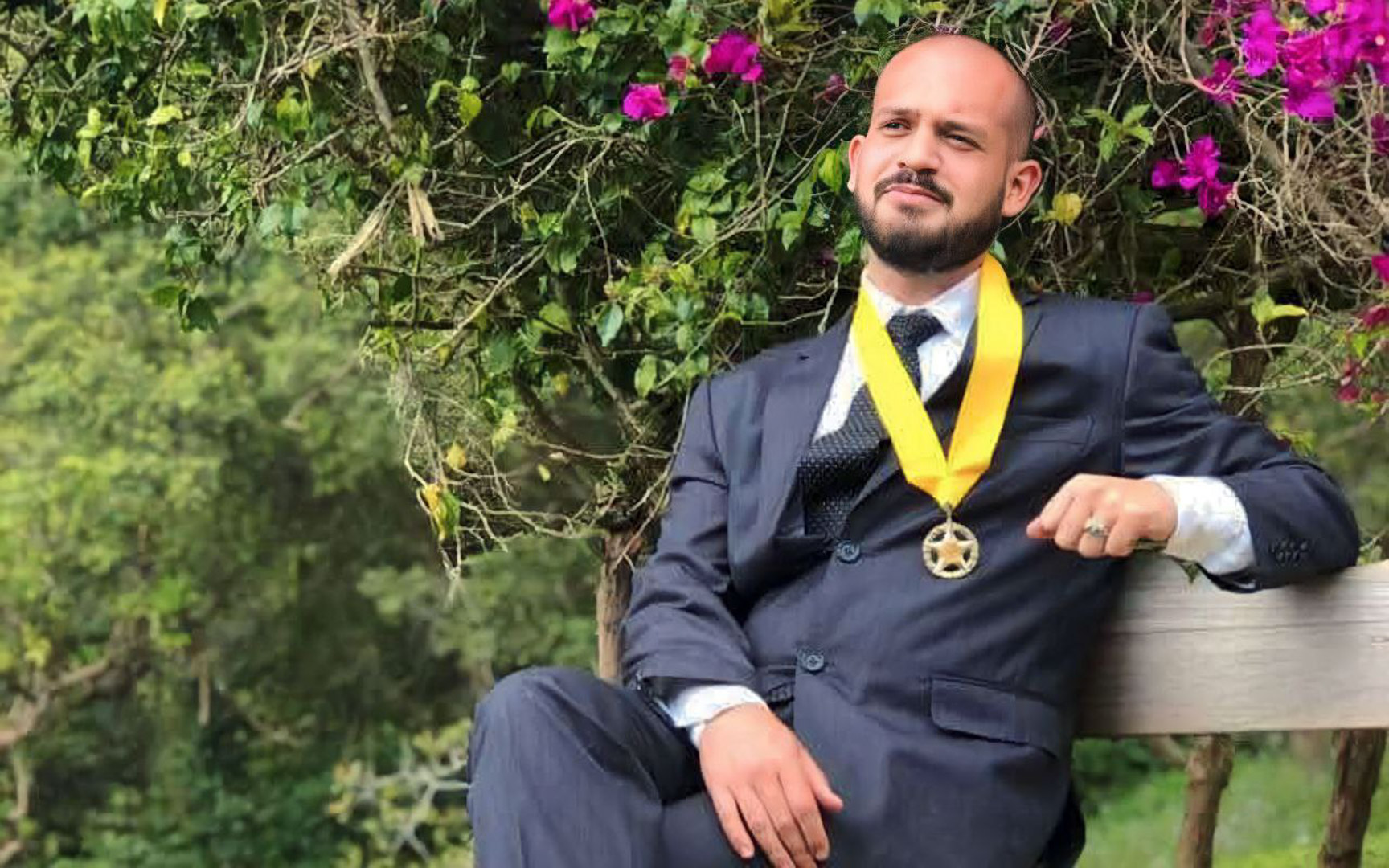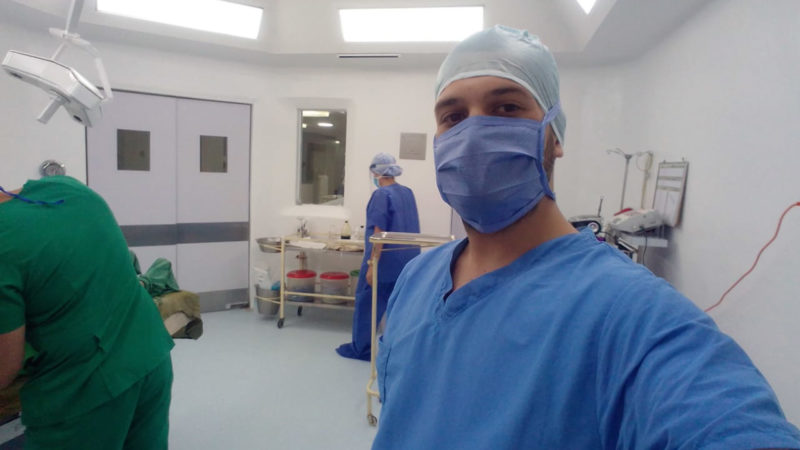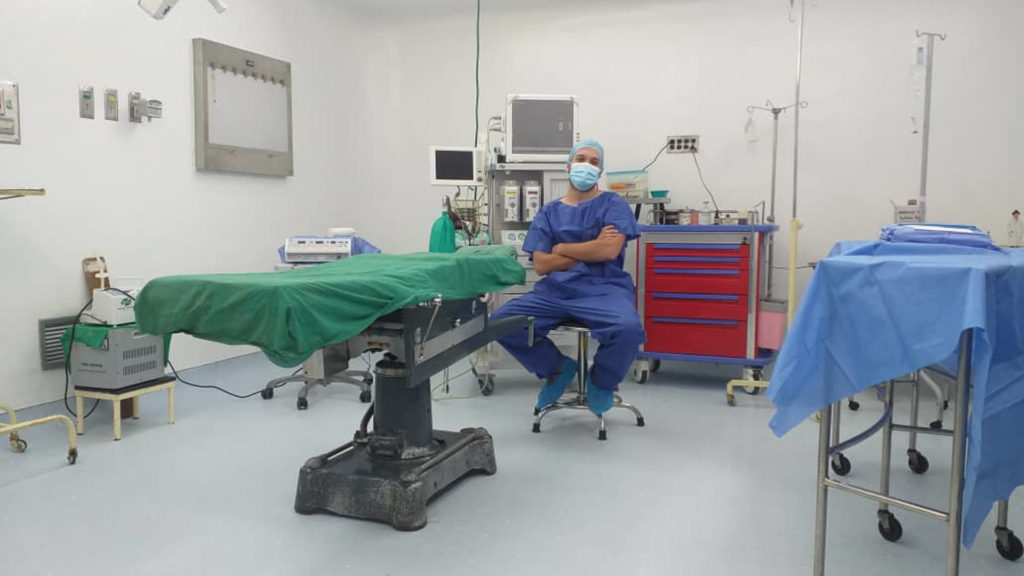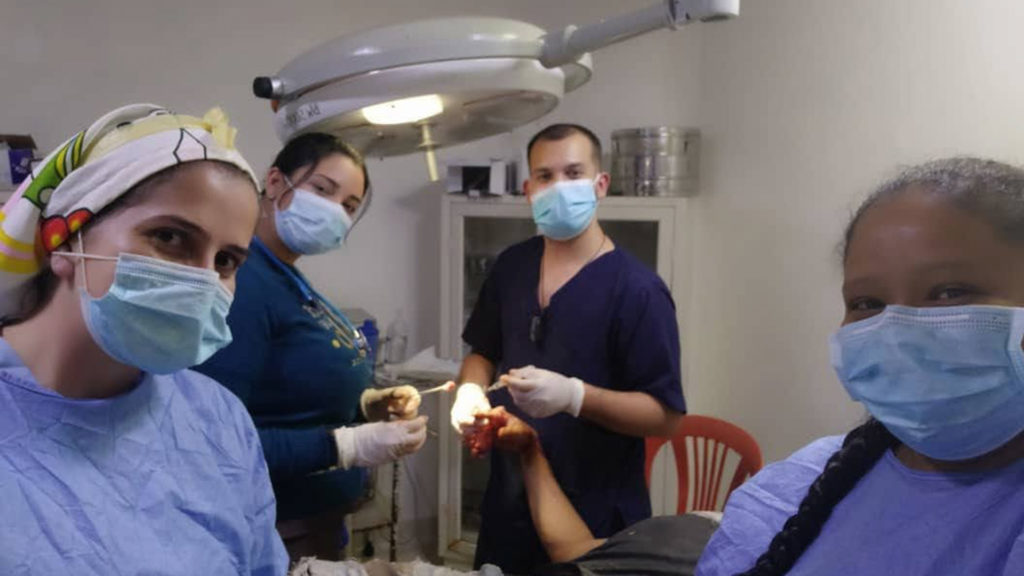


Simple things such as receiving quality care, words of encouragement or a hug can mean the world to patients. That’s what Rubén Darío Carrero learned when he was just starting practicing as a physician. This is his account of the stressful and moving experience behind this reflection.
 PHOTOS: FAMILY ALBUM
PHOTOS: FAMILY ALBUM Every single day, anywhere in any hospital, we physicians bear witness to extraordinary events that end up becoming routine work by force of habit. Tragedy can turn into hope and hope into tragedy in the blink of an eye. It’s all in a day’s work. We get used to holding our nerve in the face of circumstances, be it treating people involved in a car accident, a woman going into labor, or the victims of a shooting. Our job is to be there to provide solutions. Which is quite a challenge, given the precarious conditions of our healthcare system.
I am a medical doctor with surgical training. In March of 2020, at 27, I had just graduated from the Universidad de Los Andes (ULA), in Mérida, and was required to comply with the provisions of Section 8 [of the Law on the Exercise of the Medical Profession], according to which all physicians must complete a rural internship in a central hospital if they are to legally exercise medicine in Venezuela. I saw it as an opportunity to return to my homeland, having lived eight years in Mérida; so, I decided on La Grita, a town in the state of Táchira whose hospital was offering positions to newly graduated physicians like me.
And there I was, the morning of September 23, 2020, performing some administrative duties, following 24 hours of on-call work.
As I was leaving, at around 10:00 a.m., one of the nurses on duty told me that there was a complicated delivery case in the obstetrics area and that my fellow resident doctors were waiting for the specialist’s answer to decide what to do. The specialist in question was giving them instructions over the phone because he had not been able to get to the hospital that day for lack of fuel.
Although I had only been working at the hospital for six months, I was one of the longer serving doctors on staff, as the most senior ones had retired. I was aware of the fact that the center, despite having been designed to provide emergency surgery, lacked the necessary supplies at the time and that there were no anesthesiologists or specialists standing by to perform a cesarean section. Therefore, if the patient she was talking about needed a C-section, there was nothing we could do to help her.
Cases like that we referred to Type III or IV hospitals, which usually have graduate programs and are larger and more specialized. At that point, the closest one was the Central Hospital of San Cristóbal, a 3-hour drive from La Grita.
The delivery room is located on the second floor, which could further complicate things if the elevator was out of order —as it was more often than not—, since we would have to transport patients in wheelchairs or on stretchers with the help of stretcher bearers.
I headed there. A group of people was waiting expectantly in the small room leading to the OR. My fellow resident doctors told me that it had already been 12 hours since Maura, a 29-year-old woman, had gone into labor and that it was a high-risk case because the umbilical cord had wrapped two times around the baby’s neck, which increases labor time, causes fetal distress and, should worst come to worst, may lead to the fetus’ strangulation. In other words, only an obstetrician could determine whether or not she needed to be performed an emergency cesarean section.
Had things been different, we would have recommended that Maura be transferred to a private healthcare center for the surgical procedure. Or we would have referred her to a specialized public hospital. But we had no ambulance to transport her because there was something wrong with the one at the hospital and there was no fuel. And we couldn’t perform the procedure right there and then for the OR lacked the necessary medical supplies. Besides, the specialist was not there.
It is the physician’s duty to keep family members informed about the clinical conditions, prognosis, alternatives and potential complications of their loved ones. Easy to say, particularly considering that what the patient and her family least expect to hear is that they have to go elsewhere or that he or she cannot be taken care of for lack of supplies, fuel or staff.
We too felt helpless working under those conditions. However, we had no option but to try to come up with a solution.
By 12:00 noon, the patient had had three contractions lasting over 20 seconds in the space of three minutes. Transferring her to another center was contraindicated, and we would not have been able to, anyway, given the circumstances.
So we had to deliver the baby.
When I examined Maura, I found that the baby certainly had a double nuchal cord, which required us to create more space for him or her to pass through the birth canal, untangle the cord and cut it to allow the baby out. Although it may be considered a complication, the situation can be dealt with by use of the proper technique. However, theory alone does not suffice. You need to have had one or two guided practices or experienced the adrenaline rush of a large hospital emergency room as part of your training, neither of which I had. That’s why I asked my colleagues to let me deliver the baby but to keep an eye out for the specialist and be there should something came up that called for the activation of the emergency protocols.
The Apgar score is a test given to newborns to check their health status. It considers the baby’s skin color, respiration and activity, which tell us about his or her development and neurological function. It is the most important point of childbirth care, for it provides information on the true clinical condition of the baby and the steps to be taken. It is precisely because of this test that we have the saying “until the newborn starts breathing, no one breathes in the delivery room.”

The most significant stage of the procedure comes when the baby goes down through the final stretch and into the light. I had to proceed with caution. I had to try to remove the cord from the baby’s head, or “clamp it”, and cut it to allow him or her out. However, there are times when the umbilical cord exerts pressure from inside the uterus and the baby has a hard time coming out. This was one of those cases, and applying force from the outside was contraindicated. We were concerned because the pulling of the cord was making the baby’s head move two centimeters out, two centimeters in. Maura was doing her best to follow the instructions we were giving her as we maneuvered. Finally, after much wait and tension, the room was lightened up by the newborn’s cry: it was a boy.
We allowed ourselves to breathe too and then started assessing the child’s condition. A newborn’s good cry is one of the first factors that the Apgar test takes into account, in addition to good skin color, respiration, and muscle tone, i.e. if the newborn’s movements are strong or if the muscles are rather floppy.
Maura’s son had an optimal score.
I left the room to tell the family the news. They had heard the baby cry and were ecstatic. Maura’s mother was crying and hugging her other daughters; Maura’s father, who wouldn’t utter a word, looked anxious. The father of the newborn was also crying as he approached me:
—“Thank you, doctor, for saving the lives of my son and my wife! May God reward you for it!” he said.
Although it is frequent for patients to show their appreciation, I was struck by his words because, despite the prognosis, there had been no need to perform the C-section after all. We had just done our part.
I congratulated them both, told them that everything was going to be fine, that they should wait for additional information from the other doctors and nurses, and asked them to enjoy their son. We exchanged phone numbers just in case.
Finally, I went home.
And the case became just one of the many hospital stories that we share for a few days with our closed ones at dinner, skipping over a few details, or, in my case, during the routine call with my parents.

In September of 2020, I was surprised to receive a WhatsApp message from Maura’s husband, the father of the baby boy who was just a few days shy of his first birthday. I asked him how they were doing, told him to send my regards to his family and that I remembered them often. He replied that the baby was thriving and growing and that he was under the care of a pediatrician.
—”Doctor, there are so many soul-crushing stories about newborns, so many tragedies for their families, but that wasn’t the case for us,” he wrote.
Those words still linger on my mind.
They made me realize that sometimes such small things as providing patients with quality care, being there for them, giving them support in the face of adversity, offering them a gesture, a few words, or a simple hug, can mean the world to them. I know it is very difficult, given the political, social and humanitarian crisis facing Venezuela, but we can do invaluable things even in the midst of chaos.
We tend to believe that it takes a big change, an impressive feat or a groundbreaking surgery at a state-of-the-art facility to save the world, but miracles may come in the small things.
And one must be prepared to recognize one when one sees one.
That’s the lesson I learned from Maura and her family.
 This story was written within the framework of the “Narrative Medicine: Our Bodies also Have Stories to Tell” course taught to healthcare professionals via our El Aula e-nos online training platform.
This story was written within the framework of the “Narrative Medicine: Our Bodies also Have Stories to Tell” course taught to healthcare professionals via our El Aula e-nos online training platform.
445 readings
I was born in Táchira and I am a medical doctor from the University of the Andes in Mérida. The wheels of the world are turned by the deeds of small hands and brave gestures of courage.